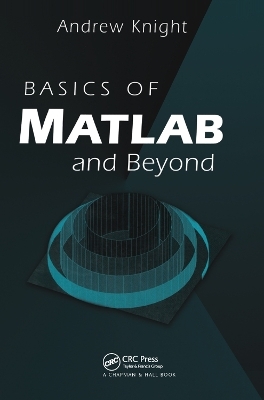
Basics of MATLAB and Beyond
CRC Press (Verlag)
978-1-138-44245-0 (ISBN)
- Titel z.Zt. nicht lieferbar
- Versandkostenfrei
- Auch auf Rechnung
- Artikel merken
MATLAB The tremendously popular computation, numerical analysis, signal processing, data analysis, and graphical software package-allows virtually every scientist and engineer to make better and faster progress. As MATLAB's world-wide sales approach a half-million with an estimated four million users, it becomes a near necessity that professionals and students have a level of competence in its use. Until now, however, there has been no book that quickly and effectively introduces MATLAB's capabilities to new users and assists those with more experience down the path toward increasingly sophisticated work.
Basics of MATLAB and Beyond is just such a book. Its hands-on, tutorial approach gently takes new users by the hand and leads them to competence in all the fundamentals of MATLAB. Then, with equal effectiveness, it covers the advanced topics that lead to full, creative exploitation of MATLAB's awesome power. With this book, readers will:
Solve more problems with MATLAB-and solve them faster
Create clearer, more beautiful graphics with control over every detail
Create their own MATLAB code
Share their work by exporting data and graphics to other applications
Develop graphical user interfaces
Based on the latest 5.x release, Basics of MATLAB and Beyond supplies both novice and experienced users the tools they need to gain proficiency, increase productivity, and ultimately have more fun with MATLAB.
The author completed a Ph.D. in plasma physics at the Flinders University of South Australia in the days before MATLAB. Consequently, he knows how much time can be saved when you don’t have to write your own matrix inversion or polynomial evaluation routines in FORTRAN. His first exposure to MATLAB was at the Centre for Plasma Physics Research at the Swiss Federal Institute of Technology (Ecole Polytechnique Fédérale) in Lausanne, Switzerland, where he continued his research in plasma physics. On his return to Australia to take up a position with the Maritime Operations Division of the Defence Science and Technology Organisation, he was given responsibility for research in the flow noise problem of towed sonar arrays. His current research interests include sonar signal processing and information displays. He has been largely responsible for the growth in the use of MATLAB in his division, and has conducted training courses in MATLAB.
I Basics of MATLAB, 1 First Steps in MATLAB, 1.1 Starting MATLAB, 1.2 First Steps, 1.3 Matrices, 1.4 Variables, 1.5 The Colon Operator, 1.6 Linspace, 1.7 Plotting Vectors, 2 Typing into MATLAB, 2.1 Command Line Editing, 2.2 Smart Recall, 2.3 Long Lines, 2.4 Copying and Pasting, 3 Matrices, 3.1 Typing Matrices, 3.2 Concatenating Matrices, 3.3 Useful Matrix Generators, 3.4 Subscripting, 3.5 End as a subscript, 3.6 Deleting Rows or Columns, 3.7 Matrix Arithmetic, 3.8 Transpose, 4 Basic Graphics, 4.1 Plotting Many Lines, 4.2 Adding Plots, 4.3 Plotting Matrices, 4.4 Clearing the Figure Window, 4.5 Subplots, 4.6 Three-Dimensional Plots, 4.7 Axes, 4.8 Labels, 5 More Matrix Algebra, 6 Basic Data Analysis, 7 Graphics of Functions of Two Variables, 7.1 Basic Plots, 7.2 Colour Maps, 7.3 Colour Bar, 7.4 Good and Bad Colour Maps, 7.5 Extracting Logical Domains, 7.6 Nonrectangular Surface Domains, 8 M-Files, 8.1 Scripts, 8.2 Functions, 8.3 Flow Control, 8.4 Comparing Strings, 9 Data Files, 9.1 MATLAB Format, 9.2 ASCII Format, 9.3 Other Formats, 10 Directories, 11 Startup, 12 Using MATLAB on Different Platforms, 13 Log Scales, 14 Curve Fitting—Matrix Division, 15 Missing Data, 16 Polar Plots, 17 Fourier Transform, 18 Power Spectrum, 19 Sounds in MATLAB, 20 Time-Frequency Analysis, 21 Line Animation, 22 SPTool, 23 Handle Graphics, 23.1 Custom Plotting Functions, 23.2 Set and Get, 23.3 Graphical Object Hierarchy, 24 Demos, II Beyond the Basics, 25 Sparse Arrays, 25.1 Example: Airfoil, 25.2 Example: Communication Network, 26 Text Strings, 26.1 String Matrices, 26.2 Comparing Strings, 26.3 String Manipulations, 26.4 Converting Numbers to Strings, 26.5 Using Strings as Commands, 27 Cell Arrays, 28 Structures, 28.1 Example: Meteorological Database, 28.2 Example: Capturing the List of Variables, 29 Multidimensional Arrays, 29.1 Generating Multidimensional Grids, 29.2 Operations with Multidimensional Arrays, 29.3 RGB Images, 29.4 Example: Sonar, 29.5 Multidimensional Cell Arrays, 29.6 Multidimensional Structures, 30 Saving and Loading Data, 30.1 MATLAB Format, 30.2 Other Formats, 31 Handle Graphics, 31.1 Get and Set, 31.2 Default Object Properties, 31.3 Current Objects, 32 Axes Effects, 32.1 The Axis Command, 32.2 Tick Marks and Labels, 32.3 Subplots, 32.4 Double Axes, 32.5 Axes Labels, 33 Text in Graphics, 33.1 Symbols and Greek Letters, 33.2 Symbols in Tick Labels, 33.3 Global Object Placement, 34 Graphical User Interfaces, 34.1 Callbacks, 34.2 UlControls, 34.3 Exclusive Radio Buttons, 34.4 Variables in GUIs, 34.5 The Tag Property, 34.6 UIMenus, 34.7 Fast Drawing, 34.8 Guide, 34.9 Other Aids, 35 Printing Graphics, 35.1 Print Size: Orient, 35.2 Print Size: WYSIWYG, 35.3 Including Figures in Other Applications, 36 Irregular Grids, 36.1 Interpolation over a Rectangular Grid, 36.2 Triangular Gridding, 37 Three-dimensional Modelling, 37.1 Patches, 37.2 Light Objects, 38 MATLAB Programming, 38.1 Vectorising Code, 38.2 M-File Subfunction, 38.3 Debugging, 38.4 Profiler, 39 Answers to Exercises (Part I), 40 Answers to Exercises (Part II), Index
| Erscheinungsdatum | 17.06.2019 |
|---|---|
| Verlagsort | London |
| Sprache | englisch |
| Maße | 156 x 234 mm |
| Gewicht | 453 g |
| Themenwelt | Mathematik / Informatik ► Informatik ► Theorie / Studium |
| Mathematik / Informatik ► Mathematik ► Computerprogramme / Computeralgebra | |
| Technik ► Umwelttechnik / Biotechnologie | |
| ISBN-10 | 1-138-44245-3 / 1138442453 |
| ISBN-13 | 978-1-138-44245-0 / 9781138442450 |
| Zustand | Neuware |
| Informationen gemäß Produktsicherheitsverordnung (GPSR) | |
| Haben Sie eine Frage zum Produkt? |
aus dem Bereich


